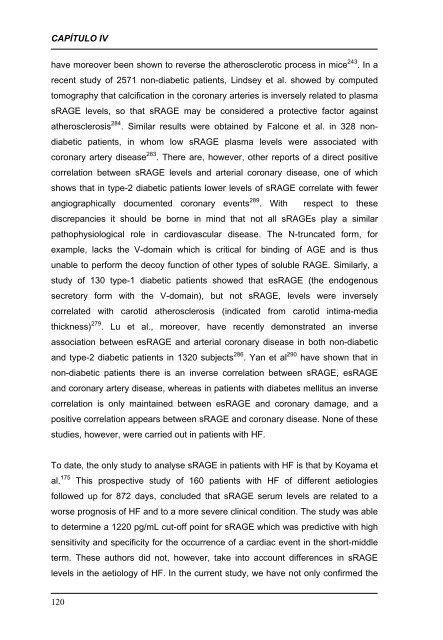INTRODUCCIÓN: REVISIÓN CRITICA DEL PROBLEMA
INTRODUCCIÓN: REVISIÓN CRITICA DEL PROBLEMA
INTRODUCCIÓN: REVISIÓN CRITICA DEL PROBLEMA
Create successful ePaper yourself
Turn your PDF publications into a flip-book with our unique Google optimized e-Paper software.
CAPÍTULO IV<br />
have moreover been shown to reverse the atherosclerotic process in mice 243 . In a<br />
recent study of 2571 non-diabetic patients, Lindsey et al. showed by computed<br />
tomography that calcification in the coronary arteries is inversely related to plasma<br />
sRAGE levels, so that sRAGE may be considered a protective factor against<br />
atherosclerosis 284 . Similar results were obtained by Falcone et al. in 328 non-<br />
diabetic patients, in whom low sRAGE plasma levels were associated with<br />
coronary artery disease 283 . There are, however, other reports of a direct positive<br />
correlation between sRAGE levels and arterial coronary disease, one of which<br />
shows that in type-2 diabetic patients lower levels of sRAGE correlate with fewer<br />
angiographically documented coronary events 289 . With respect to these<br />
discrepancies it should be borne in mind that not all sRAGEs play a similar<br />
pathophysiological role in cardiovascular disease. The N-truncated form, for<br />
example, lacks the V-domain which is critical for binding of AGE and is thus<br />
unable to perform the decoy function of other types of soluble RAGE. Similarly, a<br />
study of 130 type-1 diabetic patients showed that esRAGE (the endogenous<br />
secretory form with the V-domain), but not sRAGE, levels were inversely<br />
correlated with carotid atherosclerosis (indicated from carotid intima-media<br />
thickness) 279 . Lu et al., moreover, have recently demonstrated an inverse<br />
association between esRAGE and arterial coronary disease in both non-diabetic<br />
and type-2 diabetic patients in 1320 subjects 286 . Yan et al 290 have shown that in<br />
non-diabetic patients there is an inverse correlation between sRAGE, esRAGE<br />
and coronary artery disease, whereas in patients with diabetes mellitus an inverse<br />
correlation is only maintained between esRAGE and coronary damage, and a<br />
positive correlation appears between sRAGE and coronary disease. None of these<br />
studies, however, were carried out in patients with HF.<br />
To date, the only study to analyse sRAGE in patients with HF is that by Koyama et<br />
al. 175 This prospective study of 160 patients with HF of different aetiologies<br />
followed up for 872 days, concluded that sRAGE serum levels are related to a<br />
worse prognosis of HF and to a more severe clinical condition. The study was able<br />
to determine a 1220 pg/mL cut-off point for sRAGE which was predictive with high<br />
sensitivity and specificity for the occurrence of a cardiac event in the short-middle<br />
term. These authors did not, however, take into account differences in sRAGE<br />
levels in the aetiology of HF. In the current study, we have not only confirmed the<br />
120
















